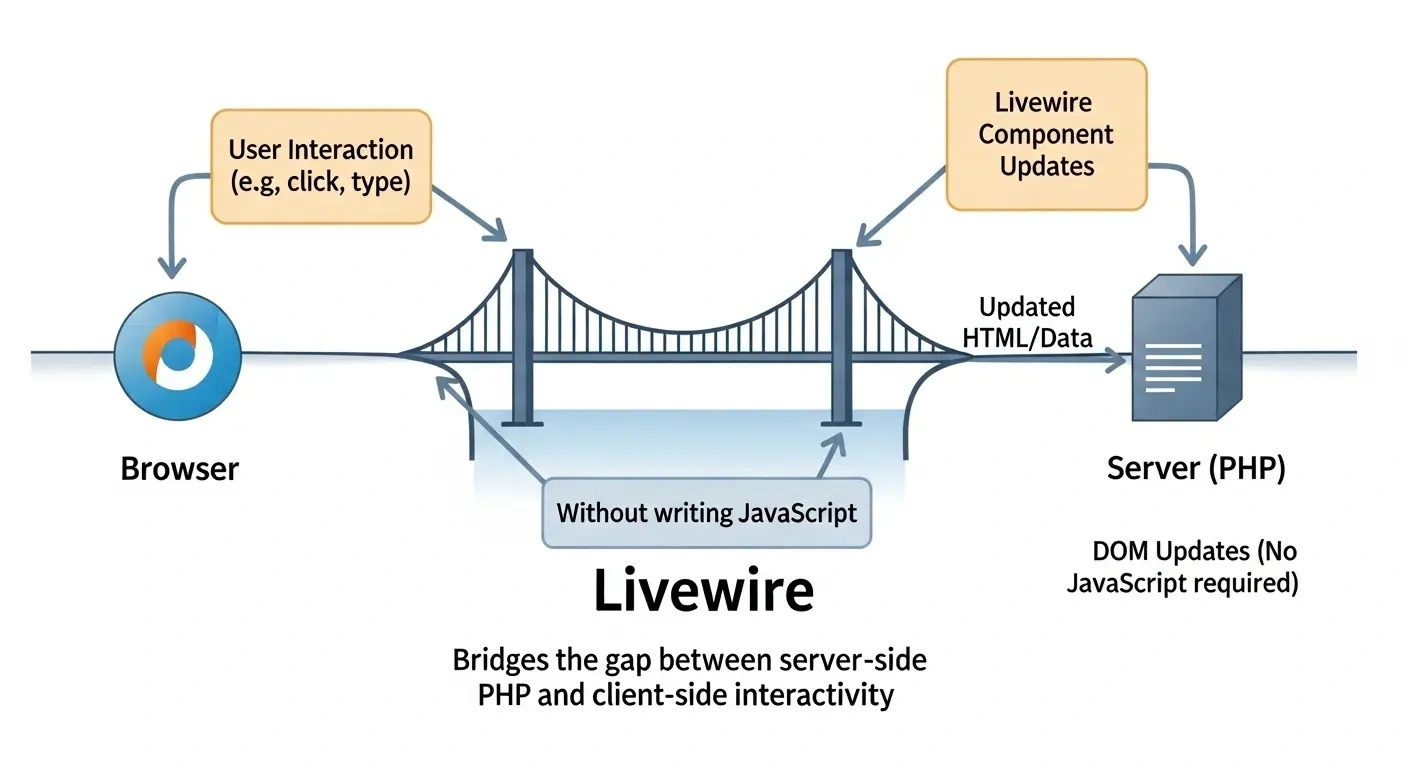Summary: Discover how Laravel Livewire enables developers to build dynamic, reactive web interfaces with minimal JavaScript. Learn about its core concepts, key features, real-world use cases, and best practices that will transform how you build interactive Laravel applications.
Table Of Contents
- Introduction to Laravel Livewire
- How Livewire Works
- Getting Started with Livewire
- Key Features of Livewire
- Real-World Use Cases
- Performance Considerations
- Best Practices
- When to Choose Livewire
- Conclusion
Introduction to Laravel Livewire
In the modern web development landscape, creating interactive user interfaces typically requires significant JavaScript expertise. Frameworks like Vue, React, and Angular have become standard tools for frontend development, but they come with a steep learning curve and often force developers to context-switch between backend and frontend mindsets.
Laravel Livewire offers a refreshing alternative: the ability to build dynamic, reactive interfaces using primarily PHP. Created by Caleb Porzio, Livewire has quickly become one of the most popular packages in the Laravel ecosystem, allowing developers to create interactive applications while staying in their PHP comfort zone.
If you're building a multi-tenant application with Laravel, Livewire's server-side approach works seamlessly with tenant isolation patterns.

How Livewire Works
At its core, Livewire uses a combination of AJAX, server-side rendering, and a sprinkle of JavaScript to create the illusion of a single-page application. Here's what happens behind the scenes:
- Initial Page Load: The server renders a Livewire component as HTML
- User Interaction: When a user interacts with the component (click, input, etc.)
- AJAX Request: Livewire's JavaScript makes an AJAX request to the server
- Server Processing: The server re-renders the component with the updated state
- DOM Diffing: Livewire intelligently updates only the parts of the page that changed
This approach gives you the reactive feel of a JavaScript framework while allowing you to write primarily PHP code.
Getting Started with Livewire
Installing Livewire in your Laravel application is straightforward:
composer require livewire/livewire
Then include Livewire's scripts and styles in your layout:
<html>
<head>
@livewireStyles
</head>
<body>
<!-- Your content -->
@livewireScripts
</body>
</html>
Creating Your First Component
To create a Livewire component, use the Artisan command:
php artisan make:livewire Counter
This generates two files:
app/Http/Livewire/Counter.php(Component class)resources/views/livewire/counter.blade.php(Component view)
Here's a simple counter component:
// Component class
namespace App\Http\Livewire;
use Livewire\Component;
class Counter extends Component
{
public $count = 0;
public function increment()
{
$this->count++;
}
public function render()
{
return view('livewire.counter');
}
}
<!-- Component view -->
<div>
<h1>{{ $count }}</h1>
<button wire:click="increment">+</button>
</div>
Then, include it in any page using the @livewire directive:
@livewire('counter')
Key Features of Livewire
Two-Way Data Binding
Similar to Vue's v-model, Livewire offers two-way data binding with wire:model:
<input type="text" wire:model="name">
<h1>Hello, {{ $name }}</h1>
Whenever the input changes, the $name property in your component is updated, and the view reflects this change.
Actions and Events
Trigger methods on your component with wire:click and other event listeners:
<button wire:click="save">Save</button>
<button wire:click="delete({{ $item->id }})">Delete</button>
For more complex event handling patterns, you might want to explore Laravel Events and Listeners for building truly decoupled applications.
Real-time Validation
Livewire makes form validation a breeze:
public function updated($propertyName)
{
$this->validateOnly($propertyName, [
'email' => 'required|email',
'password' => 'required|min:8',
]);
}
Combined with wire:model, this gives you instant validation feedback:
<input type="email" wire:model="email">
@error('email') <span class="error">{{ $message }}</span> @enderror
Loading States
Handle loading states elegantly:
<button wire:click="save">
<span wire:loading wire:target="save">Processing...</span>
<span wire:loading.remove wire:target="save">Save</span>
</button>
File Uploads
Livewire simplifies file uploads with built-in features:
use Livewire\WithFileUploads;
class UploadPhoto extends Component
{
use WithFileUploads;
public $photo;
public function save()
{
$this->photo->store('photos');
}
}
<input type="file" wire:model="photo">
If you're handling complex file uploads in your application, you might also be interested in our guide on Secure File Uploads in PHP.
Real-World Use Cases
Livewire excels in many scenarios where traditional JavaScript frameworks might be overkill:
1. Data Tables
Create sortable, filterable, paginated tables with minimal effort:
class UsersTable extends Component
{
public $search = '';
public $sortField = 'name';
public $sortDirection = 'asc';
public function sortBy($field)
{
$this->sortDirection = $this->sortField === $field
? ($this->sortDirection === 'asc' ? 'desc' : 'asc')
: 'asc';
$this->sortField = $field;
}
public function render()
{
return view('livewire.users-table', [
'users' => User::search($this->search)
->orderBy($this->sortField, $this->sortDirection)
->paginate(10),
]);
}
}
For optimizing these data tables with large datasets, check out our article on Optimizing Eloquent Performance for Large Datasets.
2. Multi-step Forms
Break complex forms into manageable steps without page reloads:
class RegistrationForm extends Component
{
public $step = 1;
public $personalInfo = [];
public $accountDetails = [];
public function nextStep()
{
$this->validate([
'personalInfo.name' => 'required',
'personalInfo.email' => 'required|email',
]);
$this->step++;
}
public function register()
{
// Process registration
}
}
3. Real-time Search
Implement typeahead search functionality with ease:
class Search extends Component
{
public $query = '';
public $results = [];
public function updatedQuery()
{
$this->results = Product::where('name', 'like', "%{$this->query}%")
->take(10)
->get();
}
}
For implementing more advanced search capabilities, consider exploring Laravel Scout which integrates perfectly with Livewire components.
Performance Considerations
While Livewire is convenient, it's important to consider performance implications:
- Lazy Loading: Use the
wire:initdirective to defer loading of components until needed.
<div wire:init="loadPosts">
@if($posts)
<!-- Show posts -->
@else
<!-- Show skeleton loader -->
@endif
</div>
-
Debouncing Inputs: Add
wire:model.debounce.500msto prevent excessive requests on frequently updated fields. -
Polling: For data that needs periodic updates, use the
wire:polldirective:
<div wire:poll.5s="refreshNotifications">
<!-- Notifications will refresh every 5 seconds -->
</div>
For more advanced performance optimization techniques, check out our comprehensive guide on PHP Performance Profiling and Optimization Techniques.
Best Practices
1. Keep Components Focused
Follow the single responsibility principle. Create smaller, reusable components rather than monolithic ones.
2. Extract Complex Logic
Move complex business logic to dedicated services or actions:
public function save()
{
$this->validate();
SaveUserAction::execute($this->userData);
$this->emit('userSaved');
}
For a deeper exploration of this pattern, see our article on Laravel Service Container: Dependency Injection Deep Dive.
3. Use Event System for Communication
Components can communicate using Livewire's event system:
// Emitting events
$this->emit('postAdded', $postId);
// Listening for events
protected $listeners = ['postAdded' => 'refreshPosts'];
4. Combine with Alpine.js for Complex UI Interactions
For complex client-side interactions, Livewire pairs perfectly with Alpine.js:
<div x-data="{ open: false }">
<button @click="open = true">Open Dialog</button>
<div x-show="open" @click.away="open = false">
<!-- Dialog content -->
@livewire('form-component')
</div>
</div>
Learn more about this powerful combination in our article on Modern JavaScript Frameworks.
When to Choose Livewire
Livewire is ideal for:
- CRUD applications with moderate interactivity
- Forms with complex validation rules
- Projects where the team has stronger PHP skills than JavaScript
- Rapidly prototyping features
- Admin panels and dashboards
However, for highly interactive applications with complex state management or animations, a dedicated JavaScript framework might still be preferable. For more complex Single-Page Applications, you might want to explore Laravel Inertia.js: Modern Monolith Applications.
Conclusion
Laravel Livewire represents a paradigm shift in how we approach interactive web applications. By allowing developers to build dynamic interfaces using familiar Laravel patterns, it bridges the gap between backend and frontend development.
Whether you're building admin panels, data tables, or multi-step forms, Livewire provides a pragmatic approach that can significantly reduce development time and complexity. Combined with Laravel's expressive syntax and powerful features, it enables you to create modern, reactive applications without leaving the comfort of PHP.
As the web development landscape continues to evolve, tools like Livewire demonstrate that there are multiple paths to creating engaging user experiences. By choosing the right tool for the job, you can focus on delivering value rather than wrestling with complex frontend architectures.
If you're building a multi-tenant SaaS application, be sure to check out our guide on Building Multi-tenant Applications with Laravel which pairs perfectly with Livewire's server-side approach.
For testing your Livewire components thoroughly, don't miss our comprehensive guide on Laravel Testing: Unit, Feature, and Integration Tests.


Add Comment
No comments yet. Be the first to comment!